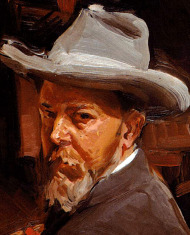While “Chelsea Visits Havana,” the first big group show of American art in Cuba was moving into place — it opened on Friday at the 10th Havana Biennial — there was other art news on the Cuban front that slipped below the radar. Credit my friend Georgina Adam, an editor-at-large at The Art Newspaper, who pointed me to it in an item in her regular Saturday column for the Financial Times.
In late February, the U.S. State Department said it would investigate the current ownership of a painting, now in the hands of an Italian-Argentinean dealer, that was confiscated from the billionaire Fanjul family in 1961, when they were forced to leave Cuba after the revolution.
The work, Malaga Porta, was painted by Joaquin Sorolla y Bastida (whose self-portrait is below), and has been variously
 valued at $250,000 to $3 million. It’s considered a minor work by Sorolla, Spain’s best Impressionist.
valued at $250,000 to $3 million. It’s considered a minor work by Sorolla, Spain’s best Impressionist.
The Fanjuls, one of Cuba’s wealthiest families before the revolution, have nevertheless been trying to get it back for years. With a fortune made in sugar and property, the dynasty owned many majestic homes in Cuba and an important art collection to go with them. It included hundreds of paintings by the likes of “Caravaggio, Goya, Murillo, Nattier, Boucher, Lebrun, Largilliere, Hoppner and Boldini, plus a Michelangelo pencil drawing, plus 14 paintings and three sketches by Sorolla y Bastida,” according to Peter Watson, who detailed this whole tangled tale in an article in The Age in 2005.
The family believes the works were largely sold onto international markets after the Soviet Union fell, leaving Cuba without a patron state and in need of hard currency.
Now, according to a press release issued on Feb. 24 by a lawyer for the Fanjuls, who started anew in the U.S. and are said to be billionaires, the State Department has agreed to probe potential violation of the Helms-Burton Act by one Bruno Sciaoli, the dealer. The Helms-Burton act blocks those who deal in property confiscated by Cuba, and their immediate families, from entering the U.S. and exposes them to potential damages.
The Fanjuls are not alone in seeking their confiscated art; they and others have listed them with the Art Loss Register, which keeps track of stolen works so that auction houses, dealers, and collectors may check before they buy or sell.
But the European Union deplored the Helms-Burton Act and passed a resolution essentially making it unenforceable in member countries. As Georgina writes:
The problem is complicated, because European governments recognise Cuba and accept the nationalisation of the collections, but under US embargo laws it is illegal to trade in confiscated property from Cuba. But if the State department finds the art dealer guilty in this test case, it could have a major impact on sales of these Cuban-sourced works. ALR executive director Chris Marinello compared the issue of confiscated Cuban art as “a similar situation to the holocaust.”
I tend to agree with Marinello: confiscation is confiscation.
The Fanjuls have long covered their political bases by donating to both Democrats and Republicans, though at one time they were particularly close to Bill Clinton. Various members contributed to both Barack Obama and Hillary Clinton in 2007-2008. Interestingly, I could not find any mention of the investigation on the State Department website.
There’ve been many articles on the Fanjul case, but the Maine Antique Digest in 2005 published the only one, by David Hewett, that I could find with a (partial) list of the Fanjuls’ lost works.
